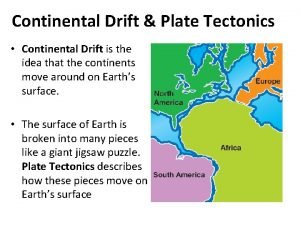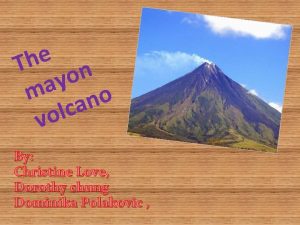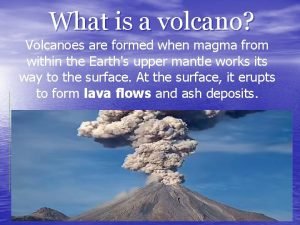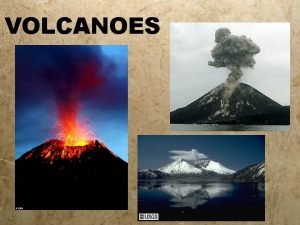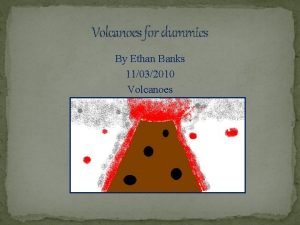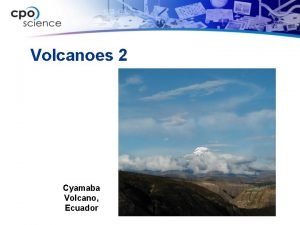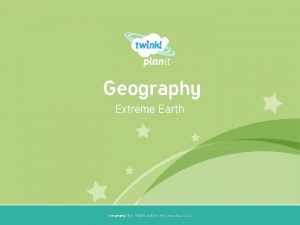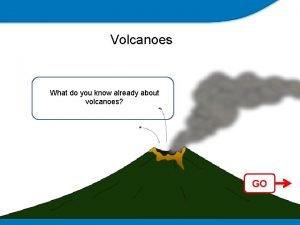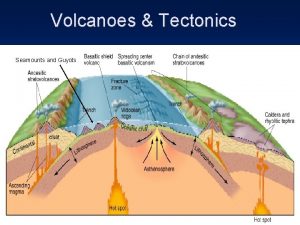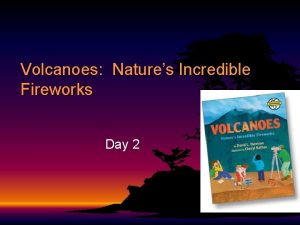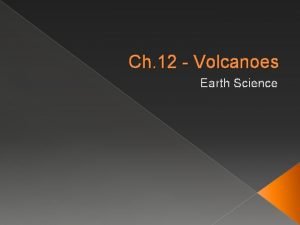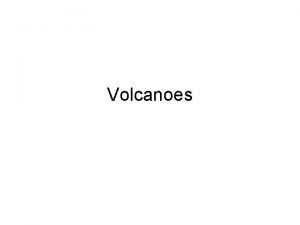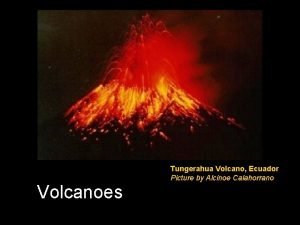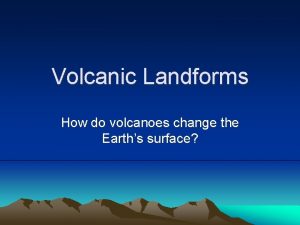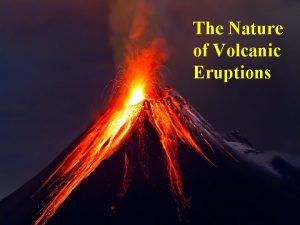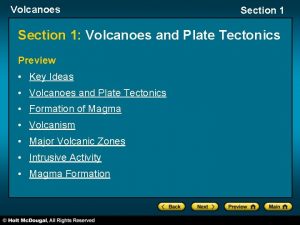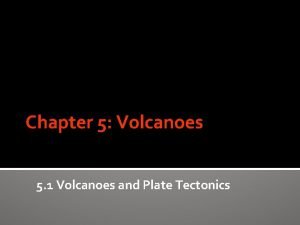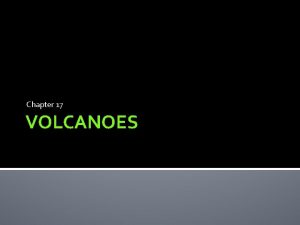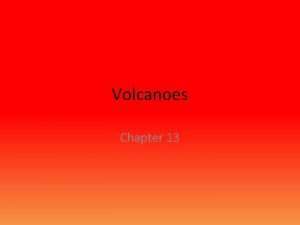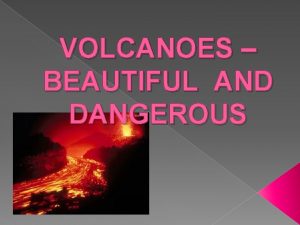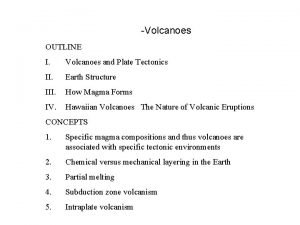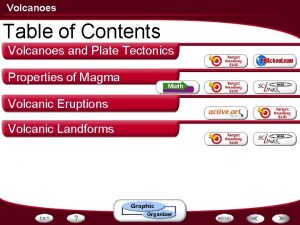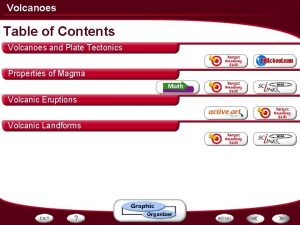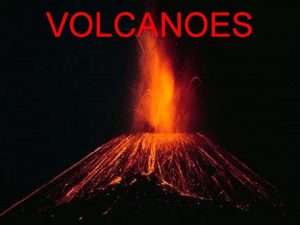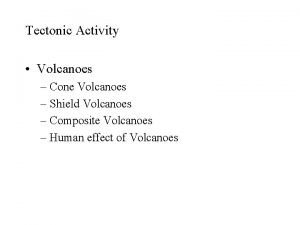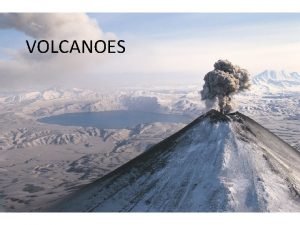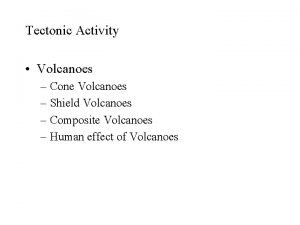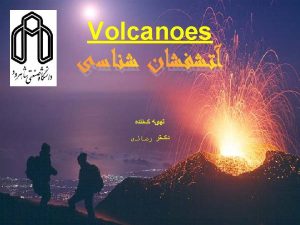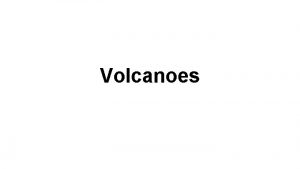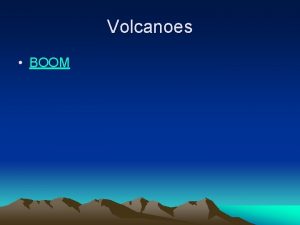Chapter 13 Volcanoes Section 1 Volcanoes and Plate





















- Slides: 21

Chapter 13 - Volcanoes Section 1: Volcanoes and Plate Tectonics

Section 1 Objectives � Describe three condition under which magma can form. � Explain what volcanism is. � Identify three tectonic settings where volcanoes form. � Describe how magma can form plutons.

What causes volcanoes? � The cause of many volcanic eruptions is the movement of tectonic plates › The movement of these plates is driven by Earth’s internal heat

Formation of Magma � Mantle is mostly solid due to high pressure, even though high temps. › Solid mantle that melts and becomes liquid rock is known as magma. � Can form under 3 conditions �Temp of rock rises above melting pt. �Pressure is reduce and melting pt. lowers �Addition of fluids may decrease melting pt. of some minerals in the rock, causing rock to melt �Fig 1, p. 319

Volcanism � Any activity that includes the movement of magma toward or onto Earth’s surface � Bodies of magma rise to the surface in 2 ways › Magma is hot enough to melts surrounding rock › Magma rises, is forced into cracks, and causes large blocks to break off and melt. This adds to the magma body

Volcanism � Lava – magma that flows onto Earth’s surface; the rock that forms when lava cools and solidifies › May flow out of a vent, cool, and build up a cone of material that may become a mountain. � Volcano – a vent or fissure in Earth’s surface through which magma and gases are expelled

Major Volcanic zones � Fig 2 – map of active volcano locations � Most occur at or near both convergent and divergent plate boundaries � Pacific Ocean – Ring of Fire › Also a major earthquake zone

Subduction Zones � Area where one tectonic plate moves under another › Oceanic plates are more dense than continental plates are usually subducted › A deep trench forms on ocean floor along continent boundary › Continental plate forms Mtns as it is folded and pushed back › Subducted plate is melted to form magma › May form volcano chain › 2 oceanic plates – island arc may form

Mid-Ocean Ridges � Divergent plate boundaries – plates are pulling away › area where largest amount of magma rises to surface › Pillow lava › Fissures – cracks through which lava flows to Earth’s surface http: //images. google. com/imgres? imgurl=http: //oceanservice. noaa. gov/education/yos/multimedia/oceanexplorer. noaa. gov/oce anexplorer. noaa. gov/explorations/04 fire/background/volcanism/pillow_lava_220. jpg&imgrefurl=http: //oceanservice. noaa. gov/e ducation/yos/multimedia/oceanexplorer. noaa. gov/explorations/06 fire/background/volcanism/volcanis m. html&usg=__h. XQKTNkm. Pc. CI 1 nil. HA 5 o. K 0 I 0 i. Ps=&h=165&w=220&sz=8&hl=en&start=5&tbnid=LW 1 Sb 8 d 9 j. Rn. KM: &tbnh=80&tbnw=107&prev=/images%3 Fq%3 Dpillow%2 Blava%26 gbv%3 D 2%26 hl%3 Den

Hot Spots �A volcanically active area of Earth’s surface, commonly far from a tectonic plate boundary � Mantle plumes – columns of hot, solid material rise and reach the lithospere › Appear to remain stationary, even though lithospheric plates drifs above the plumes. � Theory that states hot spots result from cracks in Earth’s crust.

Intrusive Activity � Magma is not dense, therefore it rises through or intrudes the overlaying layer of rock. › Magma may fracture or melt the surrounding rock. › Rock that is melted may cool again into igneous rock. � Magma may cool and solidify within the crust, resulting in many large plutons › Dikes – small plutons that are tabular in shape › Batholiths – large plutons that cover a lot of area

Chapter 13 - Volcanoes Section 2: Volcanic Eruptions

Section 2 Objectives � Explain how the composition of magma affects volcanic eruptions and lava flow. � Describe the five major types of pyroclastic material. � Identify the three main types of volcanic cones. � Describe how a caldera forms. � List three events that may signal a volcanic eruptions.

Windows to Earth’s Interior � 2 › general types of lava Mafic: magma or rock rich in Mg and Fe; commonly dark in color �Commonly makes up oceanic crust �May also make up continental crust › Felsic: magma or rock that is rich in lightcolored silicate materials �Makes up continental crust

Types of Eruptions � Viscosity – the resistance of a liquid to flow; determined by magma’s composition �This can affect the force with which a volcano may erupt �Mafic magmas are runny with low viscosity and typically cause QUIET eruptions (typically oceanic volcanoes – Hawaii) �Felsic magmas are very sticky and therefore highly viscous. �They can trap large amounts of dissolved gases, which leads to more EXPLOSIVE eruptions.

Lava Flows � Pahoehoe – mafic flows that cool & form a crust, continues to flow causing wrinkles in crust; “ropy” lava flows � Aa – forms if crust deforms rapidly or grows too thick to wrinkle, and surface breaks into jagged chunks. › Same composition but different textures due to gas content, rate and slope of flow � Blocky – Higher silica and is more viscous, forming large blocks of volcanic rock when cooled

Explosive Eruptions � Felsic lavas of continental volcanoes such as Mount St. Helens tend to be heavier and stickier (more viscous) � Contain large amounts of trapped gases, such as carbon dioxide and water vapor � During an eruption, gases escape and molten and solid particles are thrown into the air › Pyroclastic material: fragments of rock that form during a volcanic eruption

Types of Pyroclastic Material � Particles are classified according to size �Volcanic ash: particles < 2 mm in diameter �Volcanic dust : particles < 0. 25 mm in diameter �Lapilli: “little stones” < 64 mm in diameter �Generally fall near the vent �Volcanic bombs: clumps of red-hot lava that spin and cool in the air; round or spindle �Volcanic blocks: solid rock blasted from the vent; may be as large as a small house

Types of Volcanoes � Table 1, page 328 � Lava &/or pyroclastic material ejected during both quiet &/or explosive eruptions build up around the vent � Forms 3 Types of Volcanic Cones › Shield volcanoes: Broad at base with gentle sloping sides; quiet eruptions; mafic lava › Cinder cones: Very steep slope; explosive eruptions with cones of pyroclastic material › Composite volcanoes: alt. layers of hardened lava flows and pyroclastic material; a. k. a stratovolcanoes; lg. volcanic mtns.

Calderas � Large circular or basin-shaped depressions in the ground › Form when the magma chamber below a volcanic cone collapses › Figure 4, page 329 › Eruptions discharge large amounts of magma can cause a magma chamber to collapse › Krakatau: volcanic island in Indonesia exploded in 1883 forming a caldera with diameter of 6 km › May fill with water to form lakes

Predicting Volcanic Eruptions � Earthquake activity may signal a volcanic eruption before it occurs › Due to increased pressure, increased temps, or fracturing of surrounding rock › Also increased strength and frequency of quakes � Patterns › › in Activity Sides of volcano may bulge as magma moves Instruments measure tilt of ground on slopes Knowledge of previous eruptions Daily measurements vs. past measurements
 Chapter 8 earthquakes and volcanoes
Chapter 8 earthquakes and volcanoes Pour plate and spread plate difference
Pour plate and spread plate difference Oreo cookies plate tectonics
Oreo cookies plate tectonics Spread plate vs pour plate
Spread plate vs pour plate Pour plate vs streak plate
Pour plate vs streak plate A denser oceanic plate collides with a continental plate
A denser oceanic plate collides with a continental plate Interesting facts about mt mayon
Interesting facts about mt mayon What is constructive forces
What is constructive forces Volcano diagram for kids
Volcano diagram for kids How are volcanoes classified?
How are volcanoes classified? Volcanoes for dummies
Volcanoes for dummies N
N How are volcanoes made
How are volcanoes made What do you already know about volcanoes
What do you already know about volcanoes Three main ways volcanoes are created
Three main ways volcanoes are created Volcanoes nature's incredible fireworks
Volcanoes nature's incredible fireworks Types of volcanoes
Types of volcanoes How are volcanoes formed
How are volcanoes formed Volcanic belts form along _____.
Volcanic belts form along _____. Active volcanoes map
Active volcanoes map Krakatau volcano
Krakatau volcano Big island size broad slightly domed volcano
Big island size broad slightly domed volcano





